-
Microbes clean up nuclear waste -- and generate electricity
Researchers have discovered how microbes generate electricity while cleaning up nuclear waste and other toxic metals; the microbes effectively immobilize the radioactive material and prevent it from leaching into groundwater; the discovery could benefit sites changed forever by nuclear contamination
-
-
Swiss nuclear energy phase-out possible

In the wake of Germany’s decision to abandon nuclear power generation, other countries have also been examining that option; a respected Swiss research center looked into the mater, finding that restructuring the Swiss energy system without nuclear power by 2050 is in principle technologically possible and economically manageable
-
-
Studying the effects of fire on steel structures, nuclear plants
Building fires may reach temperatures of 1,000 degrees Celsius, or more than 1,800 degrees Fahrenheit, and the strength of steel structures drops by about 40 percent when exposed to temperatures exceeding 500 degrees Celsius; scientists study precisely what happens to the connections between a floor’s steel beams and the building columns when these connections are exposed to intense heat
-
-
Cutting soot emissions fastest, cheapest way to slow warming
Reducing soot emissions from diesel engines and other sources could slow melting of sea ice in the Arctic faster and more economically than any other quick fix; the good news is that decreasing soot could have a rapid effect — unlike carbon dioxide, which remains in the atmosphere for years, soot disappears within a few weeks, so that there is no long-term reservoir with a continuing warming effect
-
-
The Geophysicist's Guide to Striking It Rich
Prospecting — the search for valuable reserves such as gold, diamonds, and natural gas — is not just a matter of luck; it is about knowing where to look; now researchers at Tel Aviv University have modernized the hit-or-miss search with advanced technology that scans the earth for signs of lucrative resources that could lurk beneath the surface
-
-
Simple solution for removing arsenic from water

Almost 100 million people in developing countries are exposed to dangerously high levels of arsenic in their drinking water, unable to afford complex purification technology; scientists developed a simple, inexpensive method for removing arsenic based on chopped up pieces of ordinary plastic beverage bottles coated with a nutrient found in many foods and dietary supplements
-
-
Earthquake moves Virginia nuclear waste casks
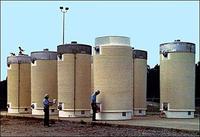
Last week’s earthquake saw caused nuclear waste casks to move up to four inches, and concrete pieces to peel off in concrete bunkers used for storing nuclear waste; the NRC says the casks and bunkers were not damaged, and no radiation leaked out
-
-
Molecules could help solve radioactive waste concerns
One component of nuclear waste — called “minor actinides” — present an extreme hazard as they are intensely radioactive and long-lived nuclides; they must be safely stored for at least 100,000 years; researchers have discovered a class of molecules that can selectively extract minor actinides, making the eventual waste far less radiotoxic
-
-
Artificial volcanoes to reverse global warming
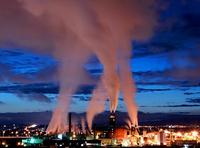
British scientists are investigating a method to reverse the effects of climate change by creating an artificial volcano and suspending it 12.5 miles above the earth; the team’s goal is to recreate the cooling effect that a volcano has when it releases millions of tiny particles into the stratosphere that bounce some of the Sun’s rays back into space
-
-
Teams dispatched to inspect Vermont nuclear plant following Irene
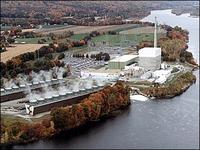
Following the torrential rains from Hurricane Irene on Sunday, federal officials have dispatched inspection teams to examine the aging Vermont Yankee nuclear plant to ensure that the plant has not been compromised; the plant has the same design as the Fukushima Daiichi plant in Japan which suffered a partial meltdown following the 11 March earthquake and tsunami
-
-
Report finds poor management cause of San Bruno natural gas explosion
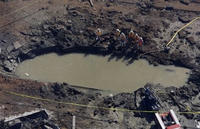
An investigation into the cause of a natural gas pipeline explosion that killed eight people and destroyed dozens of homes in San Bruno, California, placed the blame squarely on fifty-four years of bad management by Pacific Gas & Electric Company (PG&E) and the failure of state and federal regulators to notice the problem
-
-
Automated flash-flood phone alert system developed
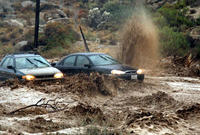
A part of Texas is called Flash Flood Alley because of the frequency and ferocity of flash floods; it stretches from San Antonio through Austin and to Dallas, and includes the Fort Hood military base; researchers develop a system which uses cell phones to give real-time text alerts of flash floods in the area
-
-
Breakthrough in hydrogen fuel cells

Hydrogen makes a great fuel because it can be converted easily to electricity in a fuel cell and because it is carbon free; the downside of hydrogen is that, because it is a gas, it can only be stored in high pressure or cryogenic tanks; a team of USC scientists has developed a robust, efficient method of using hydrogen as a fuel source
-
-
DRC wins DHS contract to help protect federal, state, and local agencies
On Tuesday Dynamics Research Corporation (DRC) announced that it had won a new blanket purchase agreement with the General Services Administration and DHS to provide a range of support services to federal, state, and local government agencies
-
-
New York's older brick buildings vulnerable

To get a better idea of just how much damage even a moderate earthquake would cause to unreinforced masonry buildings, earthquae-engineering researchers are reconstructing brick walls like those in New York City buildings that are approximately 100 years old
-
More headlines
The long view
Falling Space Debris: How High Is the Risk I'll Get Hit?
An International Space Station battery fell back to Earth and, luckily, splashed down harmlessly in the Atlantic. Should we have worried? Space debris reenters our atmosphere every week.
Using Drone Swarms to Fight Forest Fires
Forest fires are becoming increasingly catastrophic across the world, accelerated by climate change. Researchers are using multiple swarms of drones to tackle natural disasters like forest fires.
Strengthening the Grid’s ‘Backbone’ with Hydropower
Argonne-led studies investigate how hydropower could help add more clean energy to the grid, how it generates value as grids add more renewable energy, and how liner technology can improve hydropower efficiency.
LNG Exports Have Had No Impact on Domestic Energy Costs: Analysis
U.S. liquified natural gas (LNG) exports have not had any sustained and significant direct impact on U.S. natural gas prices and have, in fact, spurred production and productivity gains, which contribute to downward pressure on domestic prices.
